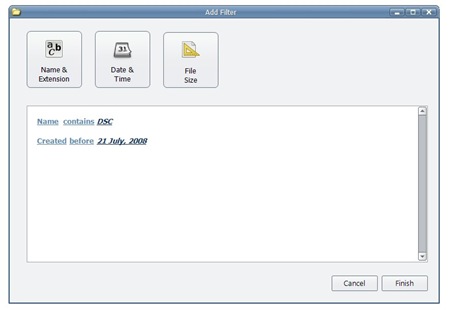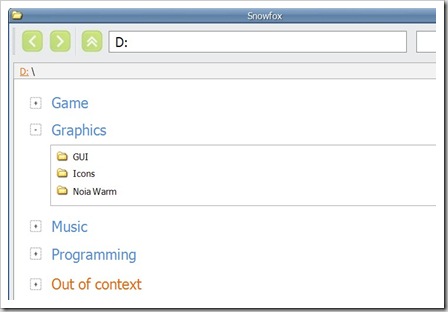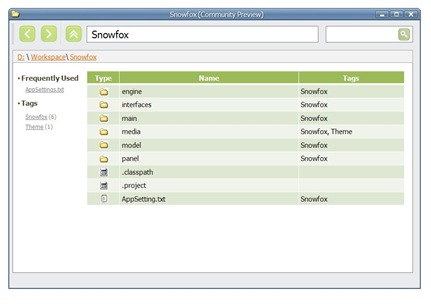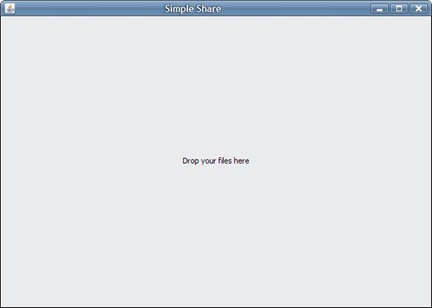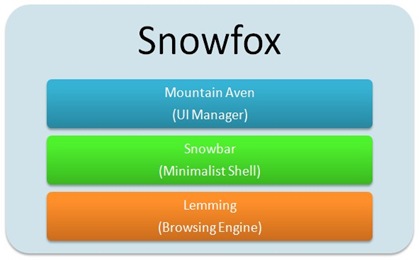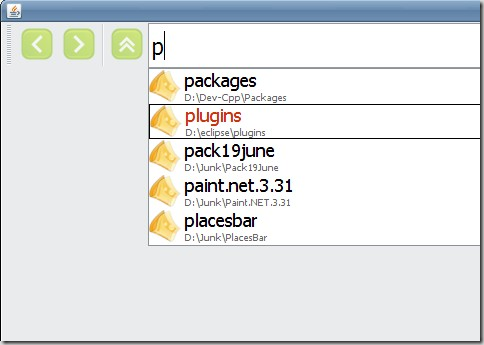This is how you can specify what files to display for a given context. File name matching can be done with normal text or regular expressions. Creation date, last modification date, and file size can also be a part of filters.
Tuesday, August 5, 2008
Sunday, August 3, 2008
About Me
You also tend to be focused on computing problems that make life easier for people, and good user interfaces... you're focused on people's experience of software, not just on interesting theoretical problems
Saturday, August 2, 2008
SnowView
SnowView: A new "contextualized" view of files. Contexts can be color coded and folded/unfolded at any time. The main UI will change based on the currently selected context.
Snowfox Development Plan
Snowfox 0.9
: Breadcrumbs
: Tabs
: Actions (toolbar & right-click)
: Contexts (full customization)
: SnowView (with Context Folding)
: Fully functional start-page with context folding
Snowfox 1.0
: Ability to zip files
: Open with Other Application (Right Click Option)
: List View, Thumbnail View
Snowfox 1.5
: File/Folder/Context Sharing
: My Friends in the Start Page
Snowfox 2.0
: Ability to sync folders with friends
: Send message to friends
Snowfox 2.5
: Natural Language Shell
Friday, August 1, 2008
Snowfox: The Semantic File Browser
So how many files and folders of your computer do you interact with? A small fraction only. The typical things we deal with everyday are office documents, home-work assignments, pictures of families and friends, music. Those of you who are technologically inclined have code written in variety of languages saved on your computer. Often you also have text-snippets storing phone numbers, random links, a chat log of a friend, an interesting idea.
Ever noticed that your file manager never bothers about what the contents really are. For all its purposes, they are just files, folder, shortcuts etc. An average file manager does not distinguish between system.ini and historyEssay02.doc, other than opening it with different applications. Its upto the average Joe to be smart and organize his "files" into folders, sub-folders, sub-sub-sub folders, meaningful file names, meaningful locations etc.
Here's a question, why should file browsing be so radically different from web browsing. When you visit a site, are you ever offered a list of file names ending with html, php, asp, pl ? How do you visit a website? Do you have to go through a heirarchy of directories to reach your favourite sites? Or do you just type the name of the site, or part of it in the address bar?
One more question, how does your browser home page look like ? Does it say C:, D:, DVD-RAM Drive E: ? It makes perfect sense to have a google search box, a personalized start page, or even a blank page as your home page. Why is it so difficult to imagine such ideas for file browsing. Why can we tag feeds and label emails but do nothing with files and folders. Why does the web guide us through words, images and links and file managers leave us with nested heirarchies of data? Who invented the file-tree anyway ?
Snowfox, is a concept of a new paradigm of file browsers. It aims to contextualize the contents of your computer. It frees you from the shackles of heriarchies and lets you visually set up contexts for your files. With contexts the browser changes itself to adapt to your needs. Snowfox is a productivity tool. It lets you get to your "stuff" quickly and more meaningfully. Its more of an organizer than a mere browser. It brings modern tools like tagging, bookmarking, scripting and makes them a part of your user experience.
Wednesday, July 30, 2008
Snowfox: Actions & Contexts
Action
An "action" in Snowfox is the equivalent of a bookmarklet in Firefox. When clicked on an "action button" a batch file / shell script is launched. Browsing information of the current location (e.g. Selected File, Current Folder etc) are made available to the script as arguments. The resulting thing is an "action", a button that can bring any command-line goodness to the file-manager. New actions can be downloaded and also created by the user. Actions that need other arguments can make requests to Snowfox to ask the user for the values of arguments. Optionally, actions can also be made available as context sensitive right click menu items. Potentially, actions give users and developers the same flexibility as add-ons. Its even better for a developer because they can simply write a batch script instead of learning a custom scripting language.
Usage: Batch Rename, Upload files to Flickr, Batch Image Resize
Context
A "context" is a way of visually tagging a file/folder. But its not tagging just for the sake of tagging. A "context" gives a special context to the item to which it is applied to. For example, you have some actions that compile and execute code. But you only need that action to show up when you are browsing code folders. Well, add a "Programming" context to your code folders. Associate the compile and execute actions to this context. Voila, everytime you browse to a code folder, all the right tools are there in front of you. Not only that, you can associate file listing types, right-click menu items, even default applications with "Contexts". Basically, the whole Snowfox GUI will change to suit the needs of the context. To spice things up more, search can be "contextual" too. This means you are no longer confined to file names and extensions. For example, you can search for files with "Family Pictures" context even if the pictures are scattered all over your computer. Adding a context will be encouraged while bookmarking. You can obviously look at your recently "contextualized" items. And as a finishing touch to this amazing feature, users will be able to create their own contexts.
Uses: Image Upload, share actions with a "Pictures" context. Code compile, execute actions with a "Programming" context.
Special thanks to darkscript for brainstorming with me and providing such amazing ideas.
Monday, July 28, 2008
Friday, July 11, 2008
Unveiling Snowfox
Thursday, July 10, 2008
SimpleShare - As simple as it gets
Have you ever found yourself in a situation where you need to take some of your files home from school, but you don't have a flash-memory. What do you do then? Mail it to yourself? Sounds logical. SimpleShare uses the same principle but does it in one single step:
Yes, that's as simple as it gets. Just drag and drop your file/folder on to the screen, and they are transferred to the root directory of your Andrew server space. Your AndrewID and password needs to entered only once. After then, every time just drag and drop.
Monday, July 7, 2008
Snowfox becomes portable
I've been scavenging the web recently for ways to open a file with its associated program on different OS's. In Windows it's pretty easy to do that. But I've been struggling with Linux and (ahem!) Macs. After a week of searching, I found it. Listed below are command line programs that do what I want:
Windows: cmd.exe /c start "path/file_name"
Linux::Gnome: gnome-open "file_name"
Linux::XFCE: exo-open "file_name"
MacOS: open "file_name"
I'm not sure about KDE yet. I've heard this command works for all versions of Linux:
xdg-open "file_name"
I haven't tried it out yet. Will post again, when I've done some tests of my own.
Saturday, July 5, 2008
Can Snowfox disrupt the use of spatial memory?
Here's a excerpt from "Designing Interfaces", a book that I am currently reading.
Many people use the desktop background as a place to
put documents, frequently used applications, and
other such things. It turns out that people tend to
use spatial memory to find things on the desktop,
and it’s very effective. People devise their own
groupings, for instance, or recall that “the document
was at the top right over by such-and-such.”
(Naturally, there are real-world equivalents too.
Many people’s desks are “organized chaos,” an apparent
mess in which the office owner can find
anything instantly.
Do people actually remember the names of their important folders, or remember their spatial locations? What a tree-view of the system gives you is not just a hierarchy, but also a way of reaching your data through a sequence of spatially organized shortcuts.
Snowfox's address bar may make it hard for most users to find their stuff, because it does not let them use their spatial memory. In this case, tags might be useful. In extreme cases where desktops are overly cluttered to even recall where an item is, it might be useful to remember something like "work", "science project".
This gives me some food for thought to think about new ways of visually organizing files based on tags and bookmarks. Maybe this might turn out to be a major interface feature.
Friday, July 4, 2008
Monday, June 30, 2008
Introducing the Snowbar
Autocompleting address bar, buttons with alpha transparency. Makes you wonder, is this Java ?? As usual, feedback is appreciated.
Snowfox Sidebar: A customized user experience
One of my original ideas for Snowfox includes a highly customizable content area. In other words, user should be able to create tabs, split tabs, open up a sidebar etc. In this post, I'm gonna talk about the Sidebar in specific. Here are the different roles that this UI element can play:
Bookmark Manager:
Firefox users should be familar with this. Usually users are able to organize their bookmarks through this window. Snowfox aims to use a similar idea. Bookmarks in Snowfox are like virtual folders where users can organize content located anywhere on their computers. As Snowfox will flatten the "tree-view" of our file system, bookmarks will be cruical to throw back some hierarchy.
Search Bar:
Okay, this is a feature "borrowed" from the traditional windows explorer. Though there is a search bar beside the addressbar, if users want more control over their searches they can do it through this special sidebar mode.
Folder Tree:
If you really really miss your old explorer, there should be no reason why you cannot make Snowfox look like it. In this mode, the sidebar shows an explorer style tree-view of folders.
Friday, June 27, 2008
Project Snowfox : Initial Thoughts
Snowfox is to your computer what Firefox is to the web. It's the accumulation of multiple productivity tools built into one useful package.
In its barebones Snowfox is a file manager like the one you get for free with Windows. But this application goes further and brings modern browsing features like tabs, bookmarks, tags, plugins, etc to your file manager.
Here are some of the ideas I have in mind:
Note: For something shorter jump to the Quick Review section.
- Why open multiple windows to copy or move files. Wouldn't it be nice to have multiple tabs where you can just drag and drop stuff?
- Why do I have to browse through the whole file system everytime I need to access my common folders? Sure I can make shortcuts, but that adds 10 more icons to my desktop. Can't I just type in the name of the folder in the address bar and go there without any of this hassle. Firefox seems to does this very well with websites.
- Okay, I can't keep all my recent files in "My Recent Files". It sure will be very useful if I can tag my files and open them up when I type in their names.
- My start menu is cluttered with zillions of programs. I need something like Launchy where I can type in the first few letters of the program I'm thinking and I can select what I want to open.
- Hey, why is the search engine in Windows Explorer so complicated ? Can't it be like a google search box that just does the right thing? I wouldn't mind firefox style search boxes where you could search for Documents, Music, Moves by simply changing the engine from the combobox.
- Removing programs in windows is a pain. Add/Remove in the control panel is SLOW ! Can't I just type: remove Program_Name.. and that should bring up the proper uninstaller. Hey, maybe I should also be able to bring up any control panel item just by typing a few letters of its name.
Quick Review
- A firefox-like file manager with multiple tabs, drag-drop support etc etc.
- A firefox 3 like smart location bar which can autocomplete file/folder names and browse/launch them.
- A location bar is also like a mini command prompt that lets you type in copy,move,rename, uninstall etc.
- A firefox like search box. Opening the combobox lets you choose different kinds of searches (documents, music, videos)
- Okay, One click bookmarking like firefox, along with the ability to tag files and folders.
- Extensible through plugins
I'm hoping to hear comments on the project idea...
Friday, May 30, 2008
Emergent Gameplay
Emergent gameplay is the creative use of a game in ways unexpected by the game designer's original intent. It commonly appears as complex behaviors that emerge from the interaction of simple game mechanisms.
I've always been keen on developing truly original game ideas. The idea of emergent gameplay hit me really hard. The originality of the game doesn't always have to come from the game designer. If the game is structured in special ways, it can be played in ways which have never been thought of before. Now that's emergent gameplay. Not only does it bring originality to the game, it also tremendously adds to the replay value of the game.
But now I'm beginning to wonder. How do we develop games that allow the rise of emergent gameplay. Is it through a complex AI system that changes unpredictably yet intelligibly with time? Or is through exploitation of a new combination of a lot of simple rules of a game?
The question is worth exploring...
Utopia-RSS: Proof of Concept
An Rss-based content creation and subscription system that will help manage school events, announcements, and reminders.
The basic idea is separate the emails you get into a variety of different feeds which you can choose to subscribe to. For example, if you want to receive event updates from Student Affairs. Subscribe to it. Don't want to receive weekly emails from the library? Don't subscribe to the library feed. Though you can still check it out if you need to. What all of this aims to accomplish is the reclamation of your inbox.
Here are the main categories of feed items that I plan to use:
1. General Announcement
- Title
- Description (Optional)
- Post Date
2. Event
- Title
- Who
- When
- Where
- Food
- Description (Optional)
- Post Date
3. Deadline Reminders
- Title
- When
- Post Date
There will be 2 different interfaces for the users. The front end is what the students will use and will basically be a customized feed reader.
The feed reader will load all the feeds the user subscribed to and filter them as following:
1. Today
2. Yesterday
3. Earlier this Week
The feed items will also be categorized by their type (i.e. event/announcement/deadline) Different type of items will be displayed differently.
The back-end of the system will be mostly for staff members and club officials. They'll be able to add new items based on their type. They will never have to access the feeds directly, all of it will be managed by a user-friendly interface provided by the back-end.
Some spin-offs of this idea:
1. A weekly planner that shows all the different events and deadlines for a week.
2. A reminder service that sends you an email reminder to all the events you agreed to attend.
3. A calendar service that lists all the assignments and tests for all the courses a student is taking.
4. A free-food finder. Based on all the feeds that have event items. List the ones that promise free food and inform you where and when to find it.
5. Integration to Google Calendar, Remember the Milk, Facebook.
